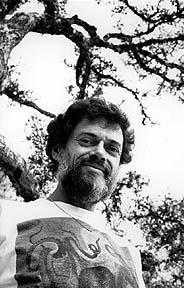Human evolution is a complex and intriguing topic that scientists and philosophers have been discussing and studying for centuries. Many theories and hypotheses have gained considerable traction over the lifetime of a question that perplexes the minds of humans to this day. Did a god create us? Are we a simulation? Did aliens genetically modify our ancestors to evolve with qualities we see as human? Finding a definitive answer to a question with so little evidence to support any one idea seems impossible, but one hypothesis developed by Terrence Mckenna, an American ethnobotanist, is particularly compelling: The Stoned Ape Hypothesis.

The human mind doubled in size around 200,000 years ago in an extremely short amount of time. In this expansion of our brains humans used tools, built fires, and developed language, all essential characteristics of modern humanity, but how could this have happened? According to Mckenna, climate change began to cause forests to recede, the slow destruction of our ancestors' habitat forced them to venture out of the safety of the forest and into the open grasslands or face extinction. In this new environment, these apes could no longer rely on their known food systems, trying new things was necessary to survival. Outside of the forest, apes adopted a new diet of insects, and embraced a nomadic hunting style to kill larger game animals. These larger primitive animals, the ancestors of cows and wildebeests, traveled in herds, the herds produce large amounts of manure which just so happens to be a cozy home to a common psychedelic mushroom, psilocybe cubensis. The primitive humans following the herds eventually come across a cow pie littered with psychoactive fungi, curiosity and hunger compels the apes to give it a try.
As we now know, these mushrooms can pack quite a punch and have a number of profound effects on the mind and body. Mckenna outlined 3 consequences of early hominid consumption of psychedelics that contributed to modern human cognition.

The first is the increase in visual acuity that magic mushrooms can cause. At high doses, psilocybin causes visual distortion and hallucinations, however at low doses, it has been shown to improve vision. Mckenna cites a study by Roland Ficher at the National Institution of Health that showed low doses improved the ability of people to determine whether or not two bars were parallel. Of course, improved visual acuity is an incredible advantage to a species relying on vision to hunt and forage. Being more efficient at acquiring food increases the survival rate as well as the rate of successful reproduction, therefore, a group of apes who used these mushrooms as a source of food, outbred the groups who did not.
Secondly, psilocybin causes central nervous system stimulation. This stimulation is hypothesized by Mckenna to lead to a heightened level of “horniness” in the apes who consume psychoactive substances. So with increased ability to get food and the increased rate of reproduction, the primitive societies of apes utilizing psilocybin continually spread their genes and knowledge of mushroom foraging to the consequent generations.
Finally, at high doses, psychedelic mushrooms cause hallucination and stimulation of broca's area, which is now associated with the formation of language. Mckenna also states that spontaneous glossolalia is a phenomenon of high dose psilocybin use. Glossolalia is described as language that “lacks consistent syntax and semantic meaning”. Essentially, it is meaningless gibberish, but could be the origin of the meaningful speech patterns we use today.
Although only appearing among Homosapiens between 30,000 and 100,000 years ago, language is widely considered to be a top contributor to the development of the human brain and is one of the most fundamental human traits. Language allows for the transfer of knowledge and organization of thought, allowing for more efficient early human societies. Once language became a part of human interaction, language continued to expand, and with that, our minds. Thinking up new words and ways to describe complex things requires data, and the more data you have the more storage you need.






Leave a comment
0 Comments